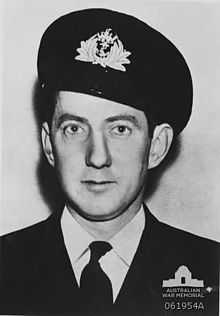John Mould
| John Stuart Mould | |
|---|---|
 | |
| Born |
21 March 1910 Gosforth, England |
| Died |
9 August 1957 (aged 47) Sydney, New South Wales |
| Allegiance |
|
| Service/branch |
Second Australian Imperial Force Royal Australian Naval Volunteer Reserve |
| Years of service | 1940–1945 |
| Rank | Lieutenant Commander |
| Battles/wars | Second World War |
| Awards |
George Cross George Medal King's Commendation for Brave Conduct |
| Other work | Chief architect to the Housing Commission of New South Wales |
John Stuart Mould GC, GM (21 March 1910 – 9 August 1957) was an Australian recipient of the George Cross.
He was born in Gosforth, Northumberland and emigrated with his family to Australia in childhood. He was appointed a sub-lieutenant in the Royal Australian Naval Volunteer Reserve (RANVR) on 1 September 1940. He sailed for the UK on the Strathmore on 14 September 1940. After training at HMS King Alfred (RNVR training establishment at Hove in Sussex). He joined the Rendering Mines Safe section on 14 December 1940 attached to HMS President for his initial introduction to his future duties. In March 1941 he was posted to HMS Vernon for duties and further training in mine disposal and was praised for "outstanding work on dock clearance operations and those resulting in the stripping of the early German mine Type G". He received a King's Commendation for Brave Conduct in June 1941 and was awarded the George Medal in April 1942.
He recovered, defused and investigated the first example of a German moored magnetic mine and was awarded the George Cross in November 1942 for "great gallantry and devotion to duty". He later worked with Doctor John Scott Haldane on developing a diving suit with an integrated air system as air bubbles from the then standard diving suits could "set" German acoustic or acoustic/magnetic triggered mines.
His appointment was terminated on 26 November 1945 when he was acting lieutenant commander attached to HMS Lanka and the staff of the Commander in Chief East Indies.[1] He was terminated in the UK as he was to take up a position on the Allied Control Commission in Germany as an architect. He returned to Australia in 1948.
After the war he was appointed chief architect to the Housing Commission of New South Wales in 1950.
In 1953 he attended the coronation of Queen Elizabeth II and was appointed acting lieutenant commander RANVR on 16 February 1953 with his appointment terminated on 15 August 1953. He died on 9 August 1957 in Royal North Shore Hospital due to peritonitis.
The story of his wartime service was told in Softly Tread The Brave – A triumph over terror, devilry, and death by mine disposal officers John Stuart Mould, GC, GM and Hugh Randal Syme, GC, GM and Bar – by Ivan Southall. A park and a memorial are found at this location .
Mould died on 9 August 1957 at the Royal North Shore Hospital, St. Leonards. He was cremated at the Northern Suburbs Crematorium, Lane Cove on 12 August and his ashes interred in the Ex-Service Personnel Wall.
Notes
- ↑ Service Documents at the NAA show this posting as CinC EI though at this time it should have been CinC Eastern Fleet
References
- Cooper, Alastair (2000). "Mould, John Stuart (1910–1957)". Australian Dictionary of Biography. Canberra: Australian National University. Retrieved 2009-02-15.
- Service documents in possession of the National Archives of Australia